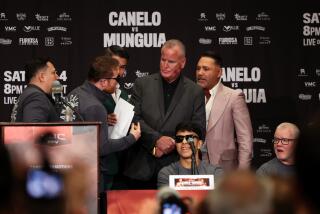Stepping it up
- Share via
Topic No. 1 regarding Manny Pacquiao’s decision to fight Oscar De La Hoya at 147 pounds is the jump in weight -- some 12 pounds greater than the Philippine star’s current standing as world lightweight champion, and a staggering 41 pounds greater than Pacquiao’s pro debut bout at 106 as a 17-year-old.
Pacquiao calls it a “nonissue.”
“It’s muscle, not fat,” Pacquiao says, crediting training and nutrition techniques. “And I won’t lose any speed. Speed can be developed in training, and that’s what I’m doing.”
Considered the top pound-for-pound fighter in the world, Pacquiao is walking around near 150 pounds. He’s buoyed by information from his trainer and promoters and is convinced he’ll extend his current eight-fight winning streak that includes victories over Mexican stars Erik Morales, Marco Antonio Barrera and Juan Manuel Marquez.
A computer study shows that, in recent years, De La Hoya’s punch and jab rate steadily deteriorates after the sixth round in his fights. Longtime Top Rank matchmaker Bruce Trampler drove in from Las Vegas to script with Pacquiao a strategy to beat the same fighter whose early career Trampler once artfully directed.
Boxing followers have tabbed Pacquiao “The Mexicutioner” because of this winning streak, and Pacquiao is confidently promising De La Hoya, 35, will be the next to fall in their Dec. 6 fight.
“I think so,” Pacquiao, 29, says, relaxing in his upscale Los Angeles apartment after a recent Hollywood gym training session. “He’s not the good Oscar I saw before. He’s still dangerous but not as good as he was before.”
Pacquiao will earn a guaranteed $11 million plus a possible pay-per-view percentage for the fight.
In training, Pacquiao (47-3-2, 35 knockouts) has practiced counterpunching options to De La Hoya’s famed left hook. His drills include stepping away from his opponent’s left and firing combinations or multiple body shots. Pacquiao ducks a left to his head, then pounds two blistering punches to trainer Freddie Roach’s body, flashing a trademark menacing glare as De La Hoya’s scorned ex-trainer tells his star, “That’s good. Always move.”
Roach makes it clear he wants Pacquiao to avoid the Golden Boy’s left, and the trainer knows his southpaw fighter packs a powerful left of his own -- one that will be helped by the use of smaller, eight-ounce gloves on fight night. Team Pacquiao has studied how De La Hoya’s face puffed up in his last fight against Steve Forbes, and is confident its boxer can scuff him up even more.
“Load up on that shot, then get off,” Roach tells Pacquiao of his left hand. “You’re never flat-footed, always on your toes. Don’t let him catch you.”
When Pacquiao initially balked at agreeing to this fight because of money -- he ended up accepting the smaller 68-32 split of the purse -- Roach told Pacquiao about the time he trained De La Hoya in Puerto Rico before his loss to Floyd Mayweather Jr. in May 2007.
“We brought in a small [106-pound] southpaw named Ivan Calderon, and Oscar couldn’t hit the guy,” Roach says. “I’ve always remembered that. He had trouble with speedy, little guys. Oscar lost control of the fight against Floyd because he didn’t cut the ring off. I told Manny I thought this would mean he could beat De La Hoya.”
Catching Pacquiao will not be easy. His closest friends brought him a Jack Russell terrier for camp, and they say the energetic little dog is the only creature who kept up with the boxer as he made frequent runs along Griffith Observatory up to the Hollywood sign.
During a training break, Roach elaborates on their strategy:
“This fight is not as much about adjusting to Oscar’s size as it is adjusting to his left hand,” Roach says. “If we can take away his jab, that nullifies his hook. You do that with constant movement, and Manny is definitely capable of keeping that up at a high level for 12 rounds. I’m counting on Manny’s youth and conditioning.”
Pacquiao describes his southpaw fighting stance as “my advantage.” He’s used to fighting right-handers like the orthodox De La Hoya and knows the history: De La Hoya has only two southpaws of note on his resume: Pernell Whitaker and an aged Hector “Macho” Camacho.
“It’s not easy for him,” Pacquiao says.
De La Hoya’s obvious strengths are his power and six-inch reach advantage, which Roach wants to counter by having Pacquiao fight “at short range” to score points early and then capitalize as fatigue hits the older fighter.
“We believe Oscar wants to get Manny out early,” says Eric Brown, Pacquiao’s assistant trainer. “Oscar’s a tough guy, but he fades real bad. We’ll take the body away, and by the eighth, Oscar will be done.”
Pacquiao is coy when asked about the plan to peak in the later rounds.
“Maybe,” he says.
Roach is more detailed.
“Timing is everything in this sport, and when you look at some history of guys coming down in weight later in their career, they get killed: Roy Jones Jr. did after he fought at heavyweight, Sugar Ray Leonard did against Terry Norris,” Roach says.
“Oscar’s going to gain 10 pounds after the weigh-in, and my guy’s speed is too much. He’ll attack Oscar all night long, and he’ll win over a lot of Oscar fans. It’s perfect timing.”
--
More to Read
Go beyond the scoreboard
Get the latest on L.A.'s teams in the daily Sports Report newsletter.
You may occasionally receive promotional content from the Los Angeles Times.











